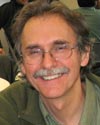 |
John Spencer, Cassini Scientist on the Composite Infrared Spectrometer (bio) Two days before the close encounter with Enceladus, there’s not much for us on the science team to do regarding the upcoming flyby except to hold our breaths and cross our fingers. We made our plans months ago, haggling over the details of where the spacecraft would point, and when, and for how long, and how much precious onboard storage space we could use. As I type, the spacecraft is arcing high above Saturn’s north pole, scanning the heat radiation from Saturn’s rings. |
It is already beginning its million-kilometer (600,000 mile) plunge towards the equatorial plane, where it will brush past Enceladus at a range of just 50 kilometers (30 miles) and a speed of 14.4 kilometers per second (32,000 miles per hour). I’m glad someone else is driving…
So I’ve been spending the morning drafting plans for our Composite Infrared Spectrometer (CIRS) observations on the next Enceladus flyby, which is on August 11th this year. We are blessed with four Enceladus flybys in 2008, each with rather similar geometry (approach over the north pole, depart looking back at the south pole), but we’ll be doing something different on each of them.
On this Wednesday’s flyby, Enceladus plunges into Saturn’s shadow right after closest approach, preventing high-resolution imaging of the south pole in sunlight. This is perversely good news for us, because our infrared detector can see in the dark, so we can do our thermal scans of the heat from the active south pole without competition from the Cassini cameras. On the August 11th flyby, however, Enceladus will be in sunlight as we look back at the south pole, so it will be the camera team’s chance for super-high-resolution imaging of the strange south polar landscape. The Composite Infrared Spectrometer will take over later, when Enceladus again goes into Saturn’s shadow, so those are the observations I’ve been sketching out today. I just e-mailed my suggestions to my colleagues John Pearl and Marcia Segura at Goddard Spaceflight Center, where John will review their scientific value and Marcia will begin the process of translating them into detailed designs.
I’m also trying to get some non-Enceladus related work out of the way before I get my hands on the new Enceladus south polar thermal scans sometime on Thursday. Once we have those data, I don’t expect to get
much other work done for a few days.

Hi greetings from Australia. Man I woulsd love your job. I have been following with great interest the wonderful acheivements of Cassinni these past 4 years. I just wanted to wish you all the very best of succes with the Enceladus flyby. I am excited so I can’t imagine what it must be like for you people who hve spent months planning it. Will you get any sleep tonight? Jason